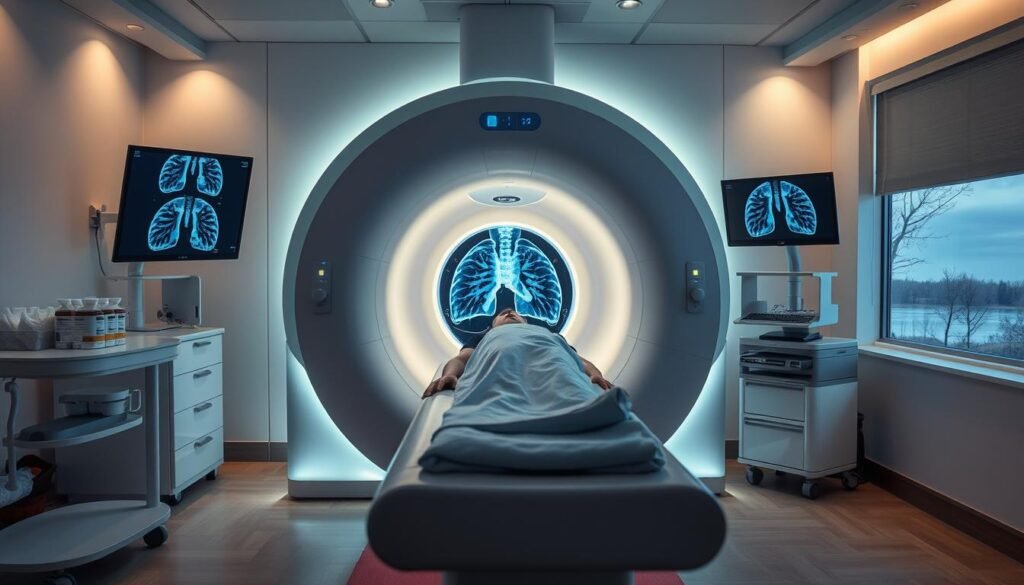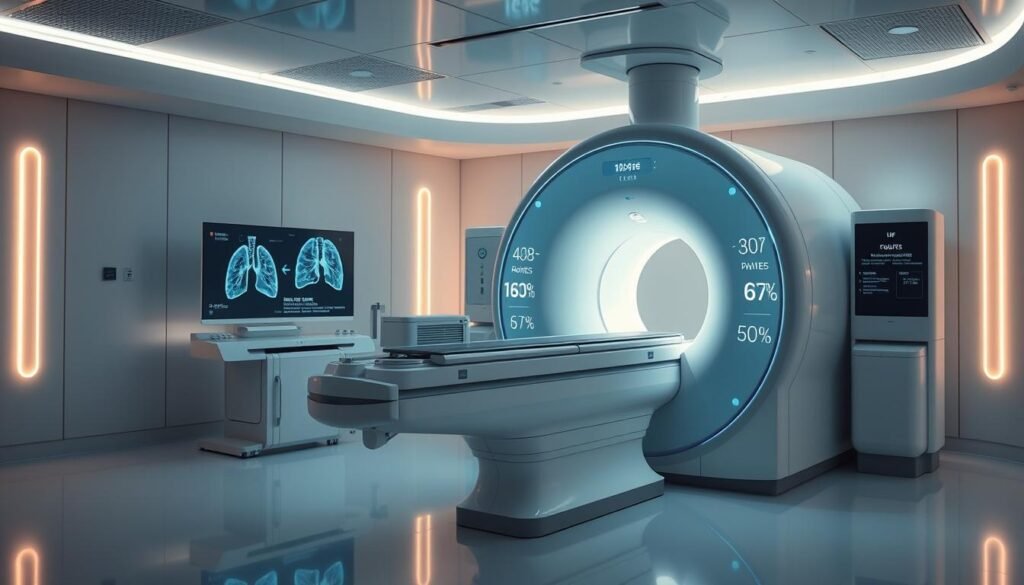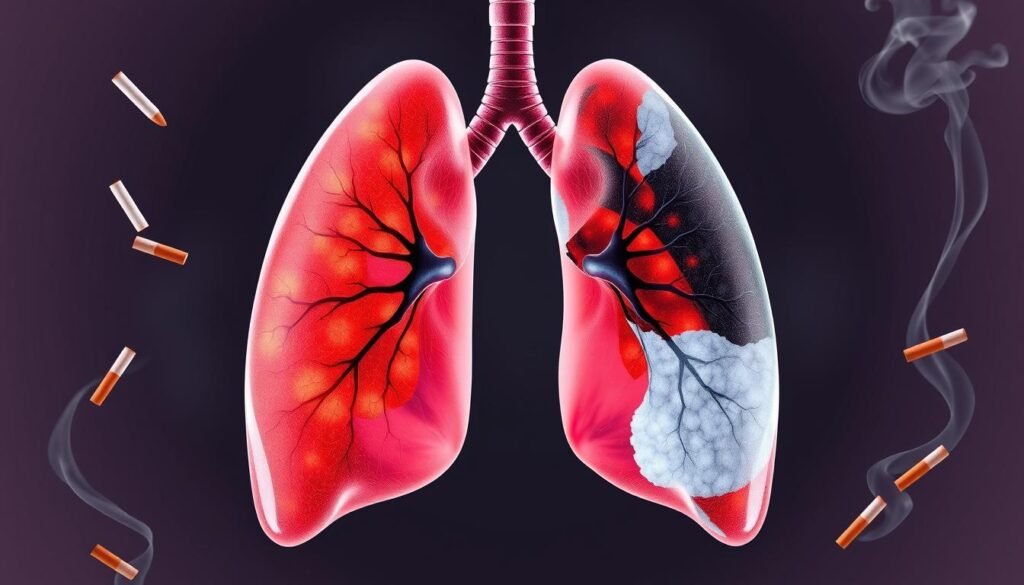In 2020, the United States saw 228,820 new lung cancer cases. This made it the top cause of cancer deaths. Spotting lung cancer early is crucial, as survival rates can jump to 63% if found at its initial stage. Low-dose CT (LDCT) screenings play a key role for those at high risk. They open the door for early action.
This screening method, including its procedure, benefits, and risks, is important to know. For those who might need lung cancer screening, it helps them make informed health decisions.
Key Takeaways
- Low-dose CT is the gold standard for lung cancer screening.
- Annual screening is recommended for those aged 50-80 with a significant smoking history.
- Screening can significantly enhance early diagnosis and survival rates.
- Black men face higher lung cancer incidence compared to their White counterparts.
- Awareness of potential false positives and risks such as overdiagnosis is crucial.
- Costs for the screening are generally covered by most insurance plans.
Understanding Lung Cancer Screening
Lung cancer screening is key in battling a disease that causes many deaths each year. It helps find lung cancer before symptoms start. This increases chances for an early diagnosis. Early diagnosis can lead to more effective treatments. This approach is crucial for better patient outcomes.
Importance of Early Detection
Early detection of lung cancer can greatly improve a patient’s prognosis. Studies show that early-stage diagnosis can yield a 5-year survival rate of up to 63%. On the other hand, late-stage diagnoses have survival rates around 5%. This shows how critical early screening is. Low-dose CT (LDCT) screenings are key for early detection and saving lives.
Survival Rates and Screening
Adults aged 50 to 80, with a history of smoking 20 pack-years, should get yearly LDCT screenings. This advice is based on studies like the National Lung Screening Trial. This trial found a 15 to 20 percent decrease in lung cancer deaths with LDCT screening. The aim is to find lung cancer early and also spot other smoker-related health issues.
Knowing the risks involved is also key. LDCT screenings are very helpful, but there’s a risk of false positives. This can cause stress and lead to more tests. Still, timely screening is vital for early diagnosis and better survival chances. For detailed guidelines, check here.
What is Low-Dose CT?
Low-dose computed tomography, also known as LDCT, is key for screening lung cancer. It uses much less CT radiation dose than standard CT scans. This makes it safer for people during checks. The LDCT scan has the patient lay on a table to take clear lung pictures quickly.
Definition and Process of LDCT
During an LDCT scan, you lie down while the x-ray goes around you in a spiral. This creates many pictures. These pictures help find tiny nodules that could be early cancer. The quickness of LDCT makes it a good choice for non-invasive screening.
Benefits of Low-Dose CT Over Traditional CT
LDCT is great because it can reduce lung cancer deaths by 20% in those at high risk. This includes people 50 to 80 years old who smoke or used to smoke. It’s also for those exposed to certain risks. Another plus is the lower CT radiation dose. This lowers the risk that comes with regular imaging. Yet, it’s important to know about the chance for false positives, which may lead to extra tests.
Screening Guidelines for High-Risk Individuals
Knowing the screening guidelines is key to spotting people at risk for lung cancer. They focus on those with a lot of smoking in their past. This way, there’s a clear plan to identify those in danger.
Age and Smoking History Recommendations
Experts recommend LDCT screens for folks 50 to 80 years old. You need a smoking history of 20 pack-years to be eligible. This means they add up your years smoked and packs a day. These rules aim to catch people still smoking or who quit recently, within 15 years.
Eligibility Criteria for Annual LDCT
To get a yearly LDCT scan for lung cancer, you can’t have symptoms. You also need to fit the smoking history and age rules. Recent changes make the process easier and stress the need for talks and shared choices before screening. Radiologists must meet specific standards, assuring scans are read correctly.
Low-Dose CT Lung Cancer Screening with or without Contrast
Low-dose CT lung cancer screening is key in finding the disease early. These scans are usually effective even without contrast agents. But, there are times when contrast-enhanced CT scans are needed for clearer images. This need is based on what the patient requires and doctors’ advice.
When is Contrast Necessary?
Contrast might be needed if initial scans show unclear lung nodules or abnormalities. It helps to see the lung structures better for diagnosing. Sometimes, guidelines highlight these cases, showing customized care in screening is essential.
Comparative Benefits of Using Contrast
Using contrast brings out details important for accurate diagnosis and planning treatment. If low-dose CT scans aren’t clear, contrast-enhanced imaging provides clarity. This approach increases diagnostic accuracy while caring for the patient’s safety and further medical needs.

It’s crucial to know when to use contrast in lung cancer imaging for the best patient care. Low-dose CT screening is the top method for early detection and has lowered death rates in those at high risk by 20%. Having the right technology for these screenings and follow-ups is vital.
Understanding Lung Cancer Detection
Finding lung cancer early is key to better outcomes for patients. Low-Dose CT (LDCT) scans are important for finding small masses, or nodules, in the lungs. While many nodules are not harmful, some can reveal a serious problem that needs more checks.
How LDCT Detects Lung Nodules
LDCT is really good at finding lung nodules. It has changed the way we catch lung cancer early. This helps us spot tumors when they’re easier to treat. People between 50 and 80, especially those who’ve smoked a lot, should consider getting checked every year. With yearly screenings, we spot over half of lung cancers early. This is much better than the 21% found without screenings.
False Positives and Overdiagnosis Concerns
LDCT is accurate, but it’s not perfect. About 12-14% of first-time tests might mistake harmless nodules for cancer. This mistake can cause a lot of stress and lead to extra tests that aren’t needed. Sometimes, LDCT finds slow-moving cancers that wouldn’t have caused any problems. This can worry people for no reason.
It’s important to weigh the benefits of finding lung cancer early against the risks of wrong results. Regular screenings every year can make false alarms less common. This shows why it’s crucial for people at high risk to keep getting checked.
| Aspect | Initial Screening | Continued Annual Screening |
|---|---|---|
| False Positive Rate | 12-14% | 6% |
| Incidental Findings Rate | 6% out of 100 | 2% out of 100 |
| Screening Age Range | 50-80 years | 50-80 years |
| Smoking History Requirement | 20 pack-years | 30 pack-years or 20 pack-years at high risk |
The Role of CT Radiation Dose
Talking about lung cancer screening highlights the importance of CT radiation dose. High-risk individuals often get low-dose computed tomography (LDCT) scans. People worry about the radiation. While LDCT shows less radiation than regular CT, adding up doses could be risky. Doctors work to use the lowest dose possible for effective results.
Radiation Risks Associated with LDCT
A low-dose CT scan gives a patient about 1.5 millisieverts (mSv) of radiation. This is way less than a standard CT scan’s 10 to 20 mSv. Comparing LDCT to standard CT, they agree well on lesions with a kappa value of 0.82. This confirms LDCT’s ability to diagnose effectively with less radiation.
Minimizing Radiation Exposure in Screening
Using LDCT for lung cancer screening lowers radiation risks and remains effective. Additionally, only screening high-risk people helps manage exposure. It’s comforting to know over 97% of lung nodules found in LDCT screenings are not cancerous. This shows screening is safe.

For healthcare professionals, it’s key to balance effective screening and low radiation exposure. Making sure patients benefit from screening while managing radiation risks is a priority.
Risk Assessment in Lung Cancer Screening
Understanding lung cancer risks is key for good screening. It involves looking at medical histories and environmental factors. Things like genetic predispositions matter a lot for health professionals.
Assessing Personal and Family History
Having a family history of cancer can increase risks. The role of smoking in lung cancer is huge, causing about 85% of deaths. It’s important for those 55-74 who’ve smoked a lot to talk about screening.
This helps find people at high risk of lung cancer early.
Impact of Environmental Factors on Lung Cancer Risk
Environment plays a big role in lung cancer risk. Being around things like radon, asbestos, and air pollution raises cancer chances. Knowing these risks helps make care plans that work better for each person.
Such plans focus on personal and external risks, making screening more effective.
The Importance of Smoking History
Knowing how smoking and lung cancer risk connect is key for screening advice. Smoking leads to about 90% of lung cancers. Doctors use smoking histories to judge screening needs and risks.
Understanding Pack-Year Calculations
A “pack-year” measures smoking habits. It’s the daily packs smoked times the years spent smoking. Smoking a pack a day for 10 years means you have a 10 pack-year history. This helps doctors decide if someone needs a screening, based on expert advice.
The US Preventive Services Task Force suggests yearly screenings for those 50 to 80. That’s for people who’ve smoked 20 pack-years or more.
Impact of Quitting on Screening Eligibility
Quitting smoking cuts lung cancer risks over years. People smoke-free for 15 years might skip yearly screenings. Their lowered risk means they avoid unnecessary tests. Quitting improves health choices and reduces lung cancer chances.

| Smoking History | Pack-Year Calculation | Screening Recommendation |
|---|---|---|
| Current Smoker | 20 pack-years or more | Annual LDCT screening |
| Former Smoker | 20 pack-years or more, quit less than 15 years | Annual LDCT screening |
| Former Smoker | 20 pack-years or more, quit 15 years or more | No screening recommended |
| Never Smoked | N/A | No screening recommended |
Follow-Up Testing and Management
After a low-dose CT scan shows something unusual, getting more tests is crucial. These may include more scans or biopsies. They help figure out if the findings are cancer or just harmless growths. The results will guide how to best look after the patient.
Next Steps After Abnormal Findings
Doctors must carefully consider what to do after finding something unusual. The next steps vary depending on the nodule’s type. But getting people to follow up is tough. Only about 42.6% of patients do follow the advice for more tests. Different types of nodules get different follow-up rates:
- 30.0% for Lung-RADS 3
- 49.5% for Lung-RADS 4A
- 68.0% for Lung-RADS 4B or 4X
Giving patients more time to follow up helps a lot. With more time, the follow-up rates get better. For example, 68.6% follow through within 9 months for Lung-RADS 3. And for Lung-RADS 4B or 4X, 80.5% do it within 62 days.
Importance of Clinical Expertise in Management
Clinical expertise is key after unusual scan results. Good care needs healthcare teams that understand the patient’s needs. They must balance the pros and cons of different treatments. This includes dealing with how stressed patients feel after these results.
Knowing how to read results is critical. This is especially true for certain nodules that might be cancer. Experts can better handle these situations, offering the right care.
Conclusion
Low-dose CT lung cancer screening is key in catching lung cancer early and managing it well. This is vital, as lung cancer is the top cause of cancer deaths in the US, with more than 235,000 new cases in 2021. Knowing the benefits of early screening can save lives.
Early detection can greatly increase survival rates. This highlights the need for immediate action in people at high risk.
However, it’s important to know about the possibility of false positives and their effects on further care. With under 20% of lung cancers found when still localized, low-dose CT screenings are crucial for improvement. Making well-informed decisions leads to timely and effective treatment, boosting survival chances.
As technology gets better, it’s vital for doctors and patients to keep learning about low-dose CT screenings. They need to understand both the good points and the limits. Knowing choices helps individuals take control of their lung health and use the resources they have.